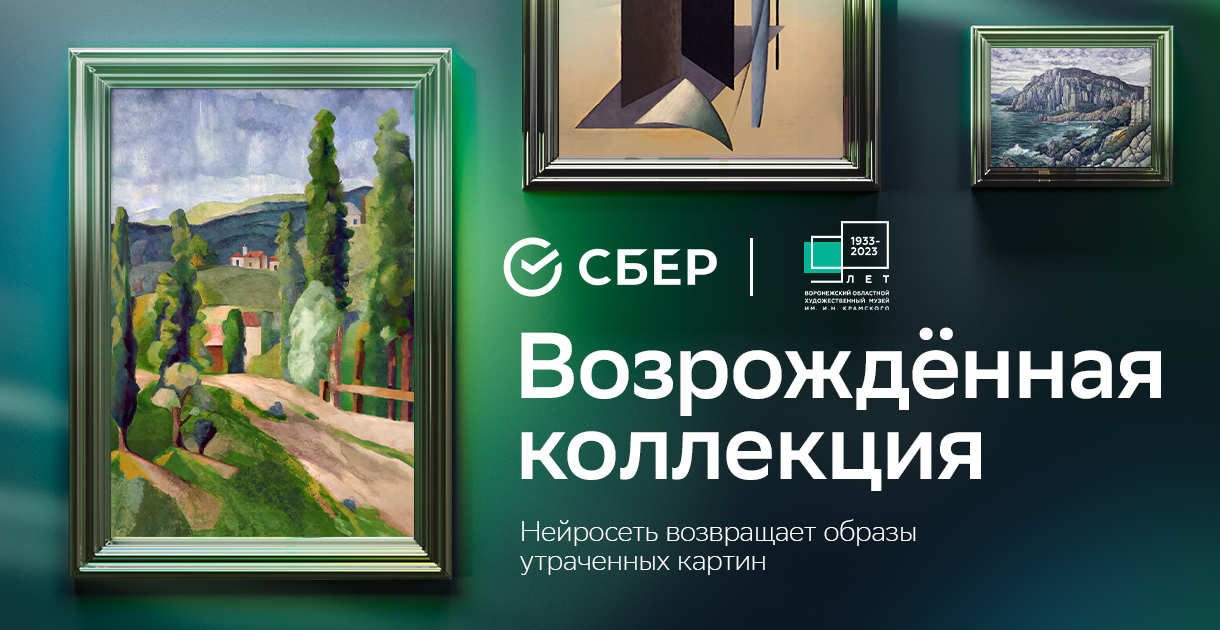
The creative concept of the REV-AI-VED ART project combines two key ideas: the preservation of cultural heritage and innovative technologies. As part of this concept, the project uses artificial intelligence, computer vision and machine learning to recreate, restore and digitalize unique historical and cultural objects. Digitization of cultural heritage makes it more accessible to a wider audience. People from every corner of Russia were able to learn about the Voronezh Regional Art Museum I.N. Kramskoy, about the lost collection of its paintings, and about the possibilities of artificial intelligence, as well as get acquainted with the paintings restored by artificial intelligence without leaving home, which makes the creative campaign socially significant. The goals of the project were to tell the widest possible audience about Sber’s Kandinsky AI and demonstrate its capabilities, showing that AI can solve problems that are significant for society and be used to restore cultural values, not just for entertainment. The REV-AI-VED ART project shows how technology allows us to take a fresh look at history and attract the attention of young people to the issues of preserving historical memory. The key idea is to reconstruct objects of visual art using only textual descriptions. This ambitious task is perfect for AI because AI image creators are designed specifically for generating images from text and, moreover, are able to analyze the huge amount of data about the works of the authors of the paintings to successfully imitate their style and manner. At the start of the project, 14 of the most iconic works from the missing collection were selected. The process of generating paintings began with Kandinsky studying the style and technique of the authors of the disappeared paintings. Then it received an array of paintings which only included those works that had been painted earlier than the lost ones. This was done to maximize the historical and artistic correspondence of the generations – it is important that the images of later paintings do not influence the generation of images recreating earlier paintings. Also, Kandinsky studied the artists’ palette and technique. The archival recordings were then adapted to the Kandinsky prompt format. After this, the process of generating canvases began, which took into account not only the subjects of the painting and the styles of their authors, but also their sizes. For different generations, different modifications of prompts were used, since the final result is affected not only by the content of the request, but also by the order of the words in it. As a result, hundreds of generated versions of each picture were made by AI. Art experts at the Voronezh Regional Art Museum chose those that most closely match the artists' styles. The most successful ones turned into the final 14 paintings, which became the REV-AI-VED ART project. The project was first announced at the largest IT conference AIJ in November 2023, which was attended by more than 3,000 people in 3 days, and viewed online by more than 50,000,000. An interactive 3D website was launched simultaneously with the opening of an offline exhibition at the Voronezh Regional Art Museum. A press announcement was made about the opening of the exhibition; the project was covered on the federal channel NTV, more than 180 media outlets wrote about it: Channel One, RBC, Komsomolskaya Pravda, Russia 1, RT, RIA Novosti, TASS, Vesti, newspaper "Culture", portal Sostav, VC.ru, telegram channels Russian marketing, Well done Sagittarius, Today in trend, Gods of marketing, Creative with an asterisk. The total reach of the campaign was 70,000,000 people; more than 600,000 unique users visited the project website. The exhibition at the Voronezh Museum was visited by 55,000 people (which is 40% higher than the usual customer flow). On March 31, 2024, in the first spring game of the “What? Where? When?" program three paintings from the project’s collection were shown, and a question was asked from a native of Kazakhstan, Kuralai Isa.
